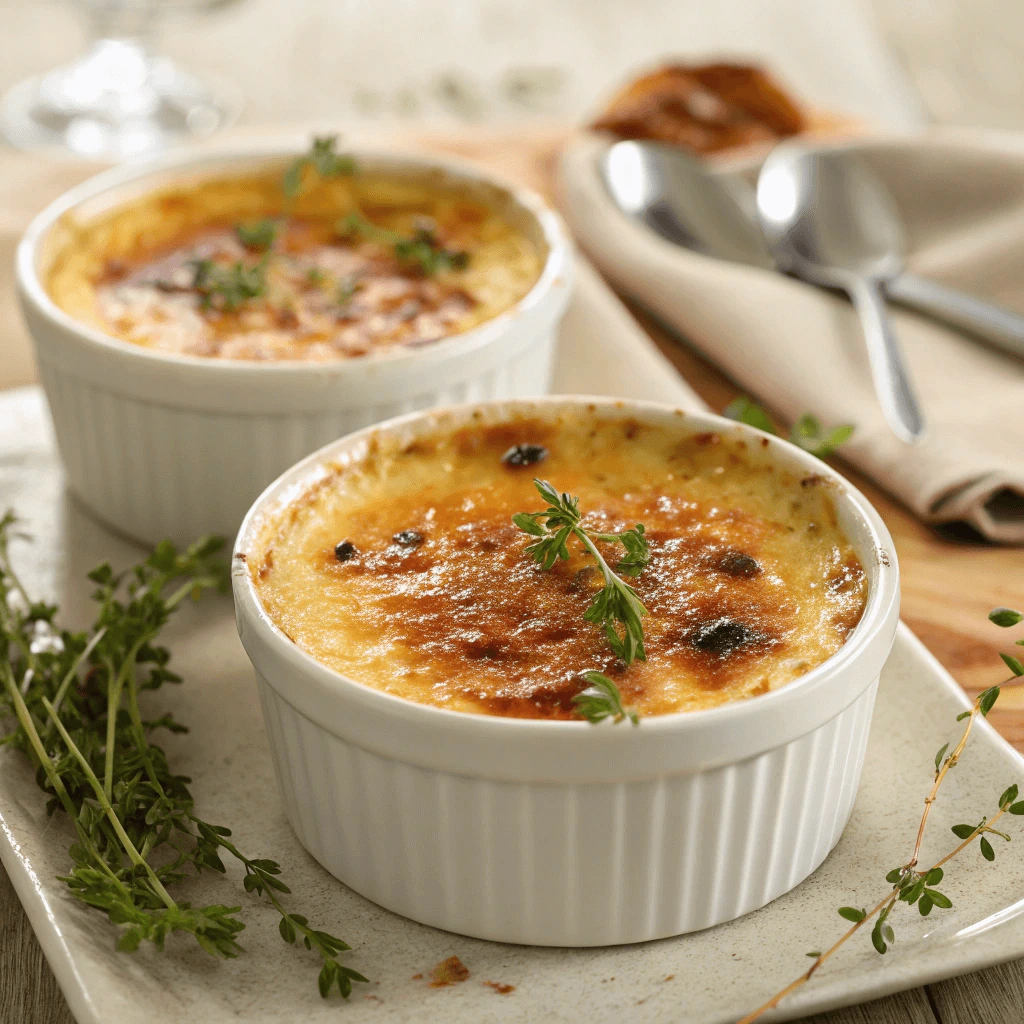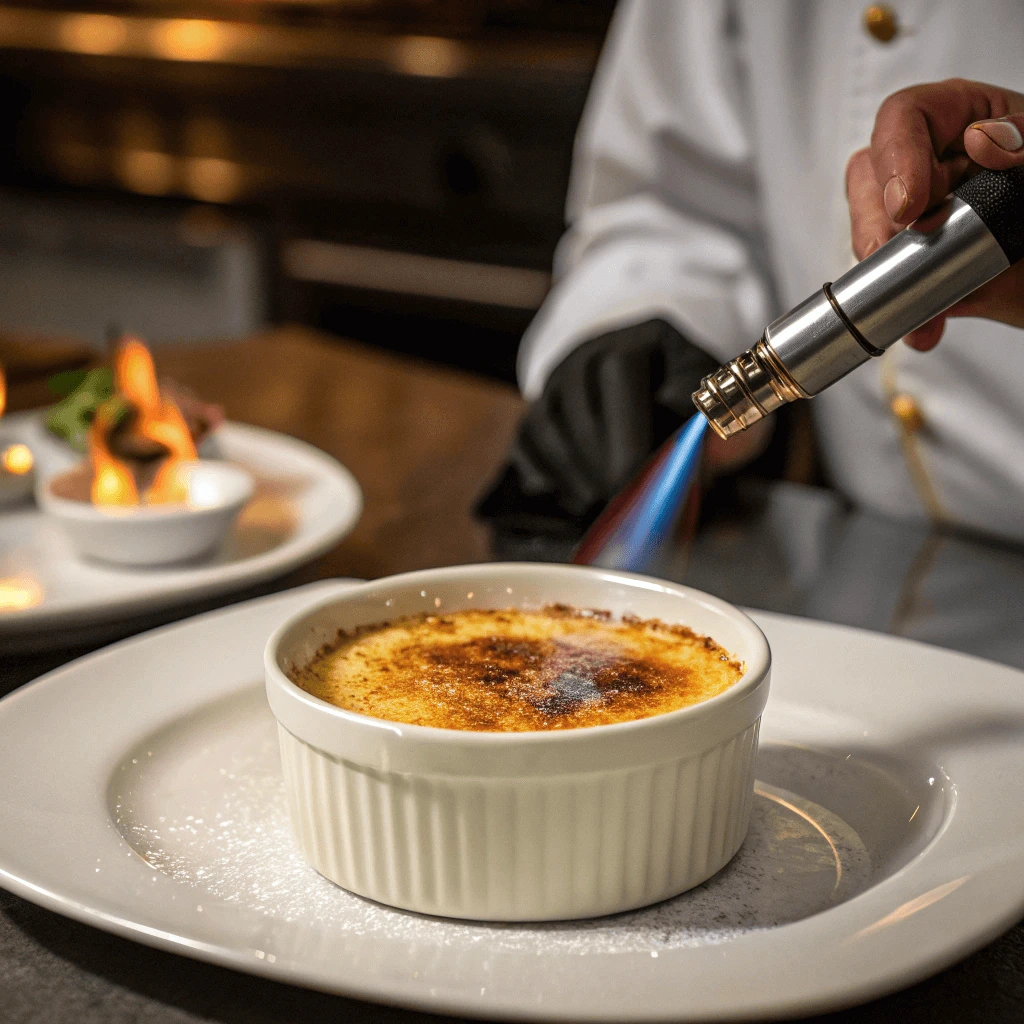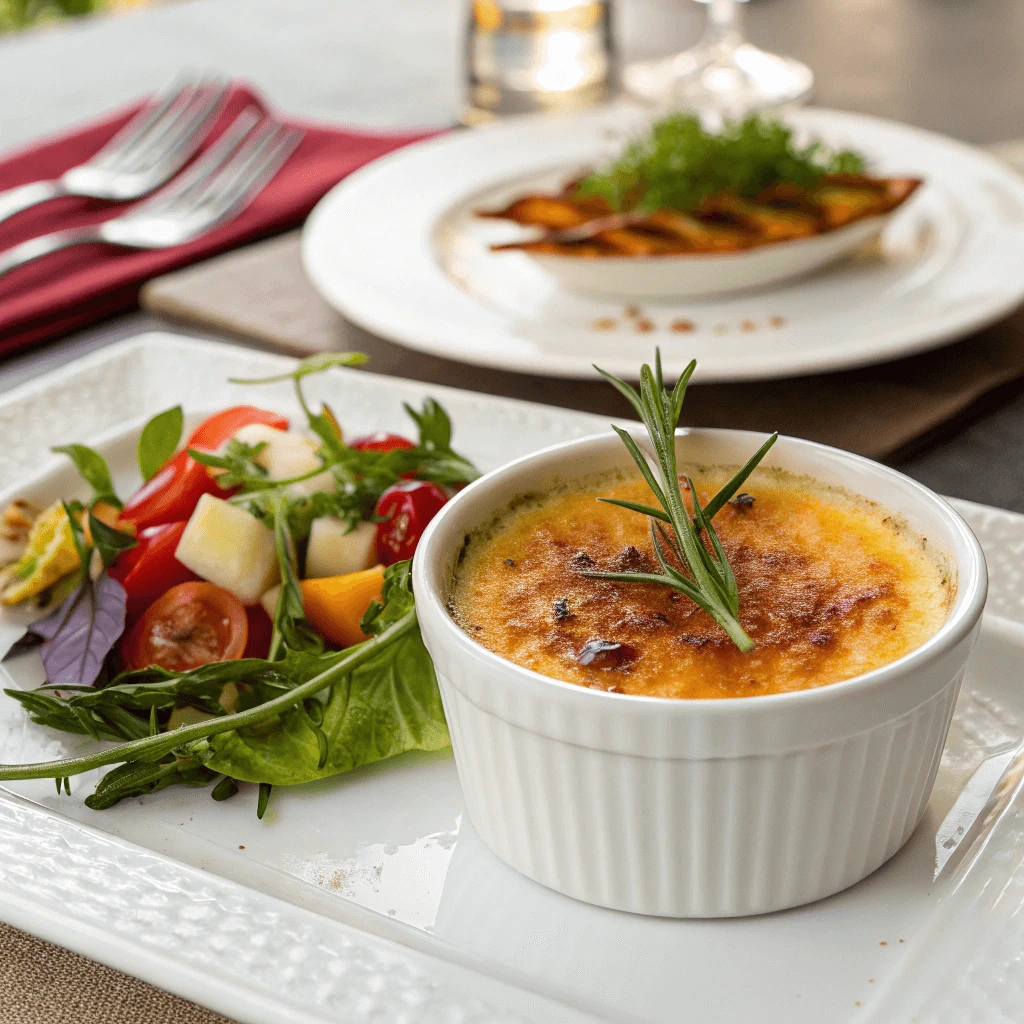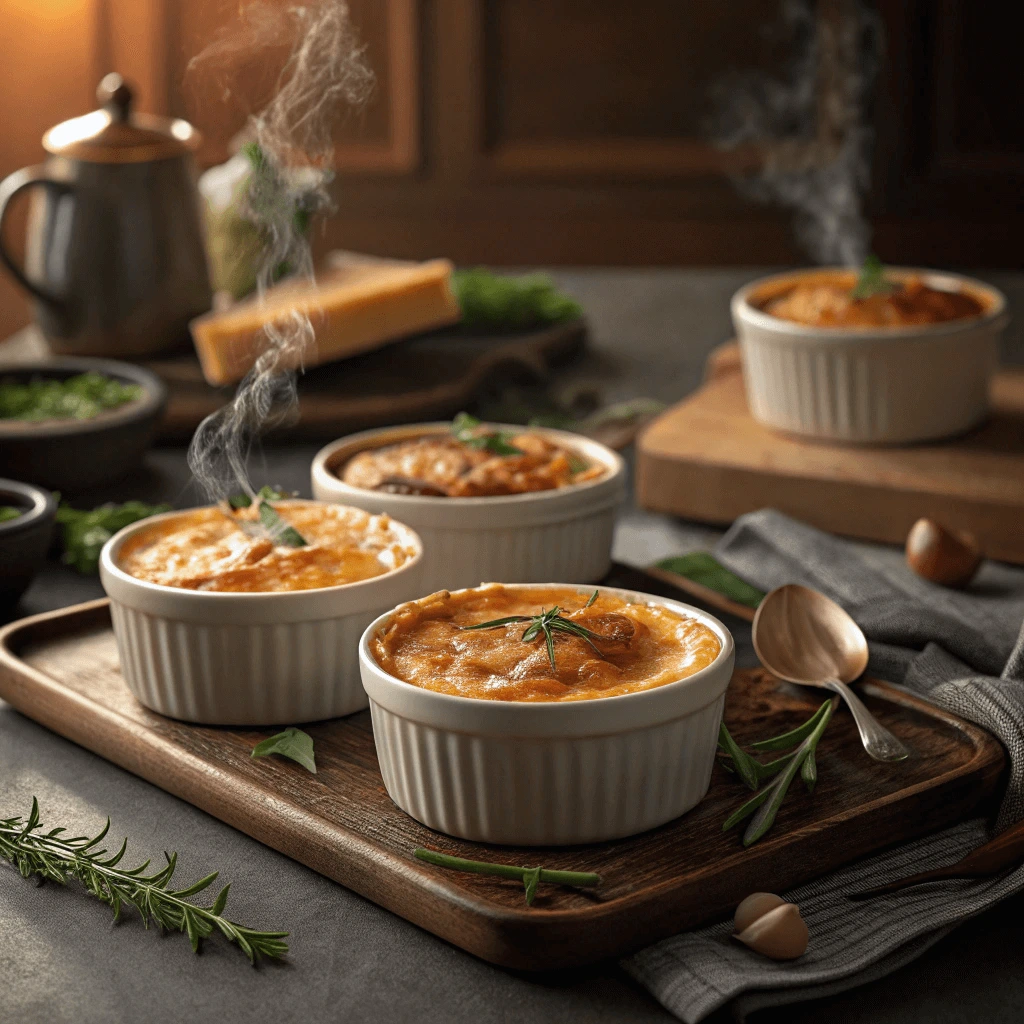The crab brulee recipe is a delightful and innovative take on the classic French crème brûlée. While the traditional dessert is known for its sweet custard base and crispy sugar topping, this savory version swaps in rich, tender crab meat, transforming it into a gourmet appetizer or main course. The perfect balance of creamy, savory, and slightly caramelized flavors makes the crab brulee a show-stopping dish. In this recipe, we’ll walk you through the steps to create this unique, delicious twist on a beloved classic.
What Makes Crab Brulee a Unique Twist on Crème Brûlée?

Exploring the History of Crème Brûlée
Crème Brûlée is a timeless French dessert, celebrated for its rich, velvety custard and signature caramelized sugar top. Its history, though debated, reflects the evolution of French culinary craftsmanship.
The Origins of Crème Brûlée
Some food historians trace the origins of Crème Brûlée back to England, where it was originally known as “Trinity Cream.” According to legend, chefs at Trinity College in Cambridge created the dessert in the 17th century. They caramelized the sugar into the shape of the college’s emblem, which gave the dish its unique charm. However, many argue that the dessert’s true birthplace lies in France, where chefs refined and popularized the recipe throughout the 18th century.
The Role of François Massialot
François Massialot, a renowned French chef, played a key role in shaping Crème Brûlée into the dessert we know today. In his 1691 cookbook, Le Cuisinier royal et bourgeois, Massialot included a recipe that closely resembles modern-day Crème Brûlée. Thanks to Massialot, the dessert became popular among the French elite, often served at royal courts as a symbol of luxury and sophistication.
Crème Brûlée’s Global Influence
From France, Crème Brûlée traveled across Europe and made its way to the United States. Chefs around the world began experimenting with different flavor variations, such as vanilla, chocolate, and fruit infusions. Despite the changes in flavor, the signature caramelized top remained unchanged, ensuring Crème Brûlée’s lasting appeal.
The Savory Crème Brûlée Concept
Crème Brûlée is traditionally a sweet dessert, but its savory variations are quickly gaining popularity. The classic custard base—made of eggs, heavy cream, and vanilla—serves as a rich foundation for savory flavors. By replacing the sugar crust with savory ingredients like cheese or seafood, chefs create a dish that balances creamy, rich textures with bold, savory notes.
A New Take on a Classic
Savory Crème Brûlée retains the traditional cooking technique but with a twist. Instead of sugar, ingredients like Parmesan, Gruyère, or even seafood, such as crab or lobster, replace the sweet topping. These ingredients complement the rich custard, offering a savory flavor experience.
Key Ingredients for a Savory Flavor
To create a balanced savory Crème Brûlée, ingredients like cheese and herbs bring out the richness of the custard. The crispy topping, made from ingredients like cheese or breadcrumbs, adds texture and contrast, enhancing the dish’s complexity.
A Creative Twist for Gourmet Meals
Savory Crème Brûlée offers a fresh approach to fine dining. Whether as an appetizer or a side dish, it elevates the meal with its refined flavors and unique presentation. This dish showcases creativity in the kitchen, making it a memorable gourmet experience.
Crab as the Perfect Filling
Crab meat is a fantastic choice for Crab Brulee because of its delicate sweetness and tender texture. The subtle flavor of crab enhances the rich, creamy custard without overpowering it. It pairs beautifully with the caramelized brulee top, creating a delightful contrast of textures.
Why Crab Works in Savory Brulee
Crab’s mild sweetness complements the custard’s richness, making it the perfect filling for a savory twist on a classic dessert. Its tender texture provides a pleasant contrast to the crisp brulee top.
Choosing the Right Crab Meat
Fresh crab meat is ideal for the best flavor. Lump crab meat offers larger pieces with a satisfying bite, while claw meat is more tender and sweeter. Be sure to pick through the meat for any shells before use.
How to Prepare Crab for Brulee
Carefully remove any shells and season lightly with salt and pepper. Gently fold the crab into the custard mixture to maintain its delicate texture. Overmixing can break down the crab, so be gentle.
Ingredients You’ll Need for the Perfect Crab Brulee

Selecting the Right Crab Meat
Choosing the right crab meat is key to making a successful Crab Brulee. The type of crab you use will impact the texture and flavor of the dish. Here’s a breakdown of the best options to help you make an informed choice.
Fresh vs. Canned Crab Meat
Fresh crab meat is always the best choice for Crab Brulee, offering a sweet and delicate flavor. Canned crab meat can be convenient but may lack the texture and flavor that fresh meat provides. If fresh crab isn’t available, frozen crab meat is a good alternative.
Types of Crab Meat to Consider
- Lump Crab Meat: This is the most popular choice for Crab Brulee. The larger, tender pieces have a firm texture and mild flavor that pairs perfectly with the creamy custard.
- Claw Meat: Claw meat has a stronger flavor and softer texture. It’s more affordable than lump crab and can add a bolder crab taste to the dish.
- Jumbo Lump Crab Meat: For a more luxurious option, jumbo lump crab offers large, succulent pieces with a rich flavor. It’s perfect for creating an elegant, high-end dish.
Preparing Crab Meat
After selecting the crab, carefully pick through it to remove any shell fragments. Pat it dry to remove excess moisture before incorporating it into your Crab Brulee mixture. Proper preparation will ensure the crab maintains its texture and enhances the overall flavor of the dish.
Essential Base Ingredients
The foundation of Crab Brulee lies in its creamy custard base, which forms the heart of the dish. Similar to traditional Crème Brûlée, the custard must be rich and smooth to complement the delicate flavor of the crab. Here’s a breakdown of the key ingredients that make this base perfect.
Eggs: The Heart of the Custard
Egg yolks are essential in creating the custard’s richness and texture. They act as a thickening agent and help bind the ingredients together. When making Crab Brulee, it’s important to handle the eggs gently to avoid curdling and achieve the silky texture characteristic of a well-made custard.
Heavy Cream: For a Rich, Velvety Texture
Heavy cream is key to the smooth, luxurious feel of the custard. The fat content in the cream ensures that the custard remains thick and creamy, complementing the crab’s delicate flavor. You can substitute it with a lighter option, but using full-fat cream yields the best result.
Seasonings to Enhance Flavor
The savory notes of the custard should be balanced with seasonings. Salt, pepper, and a hint of garlic can amplify the dish’s flavor without overpowering the crab. A sprinkle of cayenne pepper or paprika adds a subtle heat, while fresh herbs like parsley or tarragon brighten up the custard.
Parmesan Cheese: A Savory Twist
Adding Parmesan cheese to the custard gives it an extra layer of flavor and creaminess. It contributes a savory, umami richness that complements the crab and enhances the overall dish. The cheese also helps thicken the custard, giving it a beautiful texture that will form the perfect base.
Butter: Extra Smoothness
A small amount of unsalted butter can add a rich finish to the custard. While the heavy cream does most of the work, butter helps create a silky smoothness that ties everything together. It enhances the overall flavor, providing a subtle richness that rounds out the dish.
Flavor Boosters
Flavor boosters are key to taking your Crab Brulee from good to great. These ingredients enhance the natural sweetness of the crab while adding depth and complexity to the dish. Here are a few essential flavor boosters to consider.
Parmesan Cheese: A Savory Depth
Parmesan cheese adds a rich umami flavor to the Crab Brulee. When mixed into the custard, it gives a savory depth that complements the crab’s delicate taste. A light dusting of grated Parmesan on top creates a crispy, golden finish after caramelization, providing both texture and flavor.
Fresh Herbs: A Bright, Aromatic Touch
Herbs like tarragon, parsley, and chives bring a burst of freshness to the dish. They help balance the richness of the crab and custard while adding an aromatic layer. Use them within the custard or as a garnish for an extra touch of elegance.
Spices: A Hint of Heat
A dash of cayenne pepper or paprika can add a subtle warmth to your Crab Brulee. These spices offer a gentle kick without overpowering the dish. Freshly ground black pepper can also provide a mild, savory note to the custard, making the overall flavor more rounded.
Lemon: A Zesty Brightness
Lemon is a great way to add a fresh, tangy contrast to the richness of the crab and custard. A small squeeze of lemon juice or a sprinkle of zest can brighten the flavor and cut through the creaminess, creating a refreshing balance.
With these flavor boosters, your Crab Brulee will have an exciting depth and complexity, making it a standout dish.
Step-by-Step Instructions for Making Crab Brulee

Preparing the Custard Base
The custard base is key to the smooth, creamy texture that makes Crab Brulee so irresistible. Here’s a simplified breakdown to help you prepare it perfectly.
Whisking the Egg Yolks and Cream
Begin by whisking egg yolks in a bowl until they are pale and frothy. In a saucepan, gently warm the heavy cream over low heat—be careful not to bring it to a boil. Once it’s warm, slowly pour the cream into the egg yolks while whisking continuously. This gradual process ensures a silky texture without scrambling the eggs.
Adding Flavor
Once the cream and eggs are well combined, it’s time to add seasonings. A pinch of salt enhances the sweetness of the crab, while black pepper adds a subtle heat. Depending on your taste, you can also experiment with spices like cayenne pepper or a dash of nutmeg. Grated Parmesan cheese or fresh herbs can be added for extra depth of flavor.
Straining for Smoothness
To ensure a silky smooth custard, strain the mixture through a fine-mesh sieve into a clean bowl. This step removes any bits of cooked egg, leaving you with a perfectly creamy base.
Incorporating Crab Meat
Once the custard is ready, gently fold in the crab meat. Be careful not to overmix—this ensures the crab stays intact and adds a delicate texture to each bite.
Folding in Crab Meat
When folding in crab meat, it’s essential to maintain the delicate texture and natural flavor of the seafood. Here’s how you can do it properly:
Gentle Mixing
After preparing your custard base and allowing it to cool slightly, gently fold in the crab meat. Use a spatula or spoon to scoop in the crab and avoid overmixing. A soft, folding motion ensures that the crab remains in larger chunks, preserving its tender texture.
Preserving the Crab’s Texture
Take care not to break down the crab meat too much. Overmixing can make it too shredded, which affects both the texture and presentation. You want the crab to remain in distinct pieces so that each spoonful contains a satisfying bite of seafood.
Selecting Fresh Crab
For the best results, use fresh lump crab or jumbo lump crab meat. These varieties provide the perfect balance of tenderness and flavor. If using canned or frozen crab, be sure to drain it well to prevent excess moisture from affecting the custard.
Caramelizing the Top
Caramelizing the top of your Crab Brulee is the key step in transforming your dish into a beautiful, flavorful masterpiece. This step creates a perfectly crispy, golden brown top that contrasts wonderfully with the creamy crab-filled base. Here’s a closer look at how to caramelize the top to perfection:
Using a Kitchen Torch
The most common tool for caramelizing the top of a brulee is a kitchen torch. With this tool, you can apply direct heat to the sugar topping, giving it that signature crackly finish. Hold the torch about 2–3 inches above the surface of the brulee and move it in small, circular motions to evenly distribute the heat. The sugar will gradually melt and bubble before forming a rich, golden crust.
Be patient—take your time and allow the sugar to melt slowly for a smooth, even caramelization. Avoid focusing too long on any one spot, as this can burn the sugar rather than crisp it.
Alternative Method: Broiling in the Oven
If you don’t have a kitchen torch, you can also use your oven’s broiler. Place the ramekins on a baking sheet and put them under the broiler on high heat. Keep a close eye on them, as the caramelization can happen quickly. When the sugar melts and turns golden brown, remove the ramekins immediately from the oven to prevent burning.
The Key to the Perfect Crust
The perfect brulee topping should be thin, crispy, and evenly caramelized. Aim for a golden amber hue—this indicates that the sugar has reached the ideal temperature without becoming too dark. A too-dark caramel can develop a bitter taste, so be sure to monitor the color as you torch or broil the brulee.
Caramelizing the top of your Crab Brulee doesn’t just add visual appeal—it enhances the flavor too, adding a rich sweetness that balances the savory crab filling.
Tips for Elevating Your Crab Brulee
Perfecting the Custard Texture
Achieving the perfect custard texture is essential for a flawless Crab Brulee. The goal is a smooth, creamy, and velvety base that complements the savory crab filling. Here’s how to achieve the right custard consistency every time.
Low and Slow Heating
To create a smooth custard, heat it slowly over medium to low heat. Rapid heating can cause the eggs to scramble, which results in a grainy texture. Stir the mixture continuously to ensure even heat distribution and prevent curdling.
Tempering the Eggs
Tempering helps avoid scrambled eggs in your custard. Gradually add hot cream to the beaten eggs while whisking constantly. This gentle process allows the eggs to warm up without cooking too quickly, ensuring a smooth consistency.
The Right Balance of Cream and Milk
For a creamy custard, use a mixture of heavy cream and milk. Heavy cream adds richness, while milk helps lighten the texture. A 2:1 ratio of cream to milk is a great starting point for a smooth and velvety base.
Straining the Custard
After cooking, strain the custard through a fine mesh sieve to remove any bits of cooked egg. This ensures a silky smooth texture, which is crucial for your Crab Brulee.
Getting the Perfect Caramelization
Caramelizing the top of your Crab Brulee is the final touch that gives it that signature crispy, golden finish. Achieving the perfect caramelization can be tricky, but with the right techniques, you can master this crucial step and elevate your dish to new heights.
Use the Right Sugar
For the best caramelization, start with the right sugar. Granulated white sugar works well because it melts evenly and creates a smooth, even caramel. Sprinkle a thin, even layer over the top of your custard base, being careful not to overdo it. A light layer is all you need to create the desired crispy crust.
The Right Torch Technique
A kitchen torch is your best tool for caramelizing the top of your Crab Brulee. Hold the torch about 2-3 inches from the surface of the sugar and move it in a circular motion. This ensures an even application of heat. Avoid focusing on one spot for too long, as this can cause burning. The torch’s heat should melt the sugar without turning it into a black, bitter mess.
Temperature and Timing
For the perfect caramelization, the sugar should melt and bubble before hardening into a golden crust. The best timing is when the sugar begins to turn amber, but before it reaches a darker brown. A darker caramelization can add a bitter taste, so watch the sugar closely to achieve that beautiful golden finish.
Use the Right Ramekin
The type of ramekin you use can affect the caramelization process. Opt for shallow, wide ramekins, as they allow for a larger surface area of sugar to caramelize evenly. This reduces the risk of uneven caramelization, giving you a beautiful, smooth finish.
Healthy Ingredient Substitutions
Making Crab Brulee healthier is possible by swapping out some traditional ingredients for lighter alternatives. These substitutions reduce fat, calories, and sugar while still keeping the dish flavorful and creamy.
Swap Heavy Cream for Greek Yogurt or Coconut Cream
Instead of using heavy cream, try Greek yogurt for a creamy texture with fewer calories and added protein. It also adds a tangy flavor that pairs nicely with the seafood. If you’re looking for a dairy-free option, coconut cream works well too, giving a rich texture with a mild coconut flavor.
Replace Egg Yolks with Avocado
Egg yolks provide a rich texture, but avocado is a great, healthier alternative. Blending avocado into your custard mixture will create a smooth, creamy consistency and provide healthy fats without the cholesterol found in egg yolks.
Choose Low-Sodium Crab Meat or Plant-Based Alternatives
To lower sodium content, opt for fresh or low-sodium crab meat. Alternatively, plant-based crab alternatives, like jackfruit, can mimic the texture and flavor of crab, making it a great option for those seeking a more sustainable or vegan dish.
Sweeten with Stevia or Monk Fruit
For the sugar crust, use stevia or monk fruit sweetener as a replacement for refined sugar. These natural, zero-calorie sweeteners allow you to enjoy the sweet caramelized top without the added sugar and calories.
These healthy ingredient swaps allow you to enjoy a lighter, nutritious Crab Brulee without sacrificing flavor or texture.
Serving and Pairing Crab Brulee with the Right Side Dishes and Drinks
When to Serve Crab Brulee
Crab Brulee is a sophisticated and versatile dish that fits well into various occasions. Whether you’re hosting a special event or a casual gathering, this dish will impress your guests. Here are some ideal times to serve Crab Brulee:
As an Elegant Starter
Crab Brulee makes an excellent appetizer for dinner parties and formal gatherings. Its rich and savory flavor will set a luxurious tone for the meal, making it the perfect way to begin a special evening.
During a Seafood Dinner
If you’re serving a seafood-focused menu, Crab Brulee is a fantastic choice to complement other dishes. It brings a unique twist to the table, making it an impressive option for a seafood-themed feast.
For Holiday Celebrations
The festive nature of Crab Brulee makes it a great addition to holiday meals like Thanksgiving or Christmas. It’s a flavorful and elegant option that will wow your guests during festive occasions.
Crab Brulee is a versatile dish that can elevate many dining experiences, from casual dinners to formal events. Its unique combination of flavors makes it suitable for a variety of occasions.
Side Dishes to Complement Crab Brulee
Pairing Crab Brulee with the right side dishes enhances the dining experience, balancing its rich flavor with contrasting textures and tastes. Here are some options to serve alongside this decadent seafood dish:
1. Light, Refreshing Salads
A crisp salad can provide a fresh contrast to the creamy, savory flavors of Crab Brulee. Use greens like arugula or spinach, and dress them with a citrus vinaigrette to add brightness and acidity. A simple fennel salad can bring a light anise flavor that pairs perfectly with crab.
Salad Ideas:
- Arugula and Orange Salad: A citrusy salad with arugula, orange segments, and a light vinaigrette.
- Fennel and Cucumber Salad: Thinly sliced fennel and cucumber with a squeeze of lemon juice.
2. Roasted Vegetables
Roasted vegetables such as asparagus, carrots, or Brussels sprouts add a hearty, smoky flavor to balance the richness of the Crab Brulee. Their slight caramelization complements the savory notes of the dish.
Vegetable Ideas:
- Garlic Roasted Asparagus: Tender roasted asparagus with garlic and olive oil.
- Grilled Brussels Sprouts: Brussels sprouts grilled to crispy perfection with a squeeze of lemon.
3. Toasted Bread or Crostini
A warm, toasted baguette or crostini provides a satisfying crunch. The neutral flavor of the bread won’t overpower the crab but will enhance the richness of the brulee and allow guests to scoop up extra custard.
Bread Ideas:
- Herb Crostini: Lightly toasted baguette with olive oil and herbs.
- Garlic Butter Toasts: Toasted bread slices brushed with garlic butter.
4. Creamy Potatoes
For a richer side dish, creamy mashed potatoes or a potato gratin works beautifully with Crab Brulee. The smooth, buttery potatoes balance the creamy custard of the brulee.
Potato Ideas:
- Classic Mashed Potatoes: Smooth mashed potatoes with butter and cream.
- Potato Gratin: Thinly sliced potatoes baked in cream and cheese.
5. Light Buttered Pasta
A simple buttered pasta dish adds texture without overwhelming the flavors of the Crab Brulee. Its delicate taste complements the crab’s sweetness and provides a mild contrast.
Pasta Ideas:
- Linguine with Lemon Butter: Linguine tossed in a light lemon butter sauce.
- Angel Hair with Garlic and Basil: Angel hair pasta with garlic and fresh basil.
When serving Crab Brulee, the key is to choose side dishes that enhance the dish’s flavor while offering contrasting textures and tastes. Whether opting for a fresh salad, roasted vegetables, or creamy potatoes, these side dishes will create a well-rounded and memorable meal.
Non-Alcoholic Drink Pairings
Pairing non-alcoholic drinks with Crab Brulee is a great way to complement its rich, savory flavor while maintaining a light and refreshing balance. Here are a few drink options that work well with this dish.
1. Sparkling Water with Lemon or Lime
Sparkling water, especially with a splash of lemon or lime, is a perfect match. The bubbles help cleanse the palate, while the citrus adds a refreshing zing that cuts through the richness of the Crab Brulee.
2. Iced Green Tea
Green tea, served iced, has a mild, slightly grassy flavor that pairs beautifully with Crab Brulee. Its subtle bitterness balances the creamy custard, offering a refreshing contrast to the dish.
3. Cucumber Mint Cooler
A cucumber mint cooler is a light and herbal drink that adds a cool, refreshing touch. The cucumber gives a crisp flavor, while the mint refreshes your palate between bites.
4. Fresh Lemonade
Fresh lemonade, particularly with a hint of basil or thyme, offers a tart, citrusy burst. The acidity complements the rich, creamy texture of the Crab Brulee, making each bite feel lighter.
5. Herbal Iced Tea
Herbal teas like chamomile or hibiscus bring floral and slightly sweet notes. These teas are subtle enough not to overpower the Crab Brulee while enhancing its delicate flavors.
These non-alcoholic beverages bring refreshing balance to the richness of Crab Brulee, enhancing its flavors and making your meal even more enjoyable.
Conclusion: A Fresh and Savory Take on a Classic
Crab Brulee offers a creative twist on the classic French dessert, combining rich seafood flavors with the smooth, creamy texture of a traditional crème brûlée. Its savory depth and delicate sweetness make it a unique and sophisticated dish. Whether you’re a seasoned chef or a home cook, experimenting with Crab Brulee can bring exciting results to your kitchen. Don’t hesitate to try different crab varieties or flavor enhancements to make this dish your own. Enjoy crafting this memorable gourmet creation!
